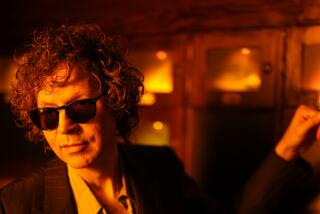The Soul of Dance Music
It was odd to see hundreds of people sitting and staring, rather than dancing, as an electronic/dance music trio opened for Moby on Sunday at the Greek Theatre.
The group, Hybrid, certainly generated enough intensity and rhythm with its synthesizers and percussion devices during a 45-minute set to have kept the floor occupied if it had been playing in a sympathetic dance-club setting. But its music was too generic by far to stir much interest in this concert environment.
By contrast, the same fans sprang to their feet and moved about freely in front of their seats as soon as Moby came on stage--and the difference in reaction helps illustrate why Moby is one of the most important arrivals on the pop scene over the last decade.
The New Yorker has captured the imagination of a broad pop audience because his music transcends its dance-world roots by putting a human face and, one might say, soul, into an often anonymous style.
By doing so, Moby has helped build a bridge for dance music to a wider pop-rock audience, the same way Sly & the Family Stone helped transform funk music in the â60s and Bob Marley reggae in the â70s.
Mobyâs secret is that he doesnât inject anonymous pop elements into the dance-floor textures the way so many dance acts do when trying to expand their audience. He draws on gospel, rock, folk, blues and even punk elements to give character and dimension to his sound.
He also endows the music with stirring and identifiable themes, many of which touch on questions of spirituality and human need. His âWhy Does My Heart Feel So Bad?â--a glorious exercise constructed around vocals by the Shining Light Gospel Choir--is about as universal an expression of self-questioning as one can imagine.
The songwriter and multi-instrumentalist put together an electronic package so original and appealing in last yearâs âPlayâ that it was named the best album of the year in the Village Voiceâs annual poll of U.S. pop critics. The collection has also sold more than 1.1 million copies in the U.S., and every track on the album has been licensed for use either in a motion picture, TV show or commercial.
But Moby adds an entirely new, liberating layer to the music in performance, turning the stage into a virtual laboratory of imagination as he redesigns the songs in novel and appealing ways with the help of three musicians (a DJ, drummer and bassist), backup singer Diane Charlemagne and a storehouse of prerecorded elements.
Moby raced around the stage Sunday as frantically as the beats in his music, switching between acoustic and electric guitars, synthesizer, congas and the microphone, where he handled some of the eveningâs vocals himself.
If youâre familiar with his albums, you pretty much knew which songs he would be doing Sunday, including âWhy Does My Heart Feel So Bad?â and the lustful âHoney.â
But you never quite knew how they would turn out. âEverytime You Touch Me,â a vigorous disco number from Mobyâs 1995 album âEverything Is Wrong,â got an acoustic treatment, and he turned in a gospel rendition of âFeeling So Real,â another disco number from the same album.
And then there were the wild cards, such as his straightforward, acoustic slice of Neil Youngâs âHelplessâ--an ode, he said, to the fact that the song was probably written in the âvalleys and canyons around here.â
Beck may have defined the spirit of â90s techno-pop in a single phrase--âtwo turntables and a microphoneâ--but Moby may be looked back upon as the true Pied Piper of modern electronic music.
More to Read
The biggest entertainment stories
Get our big stories about Hollywood, film, television, music, arts, culture and more right in your inbox as soon as they publish.
You may occasionally receive promotional content from the Los Angeles Times.










